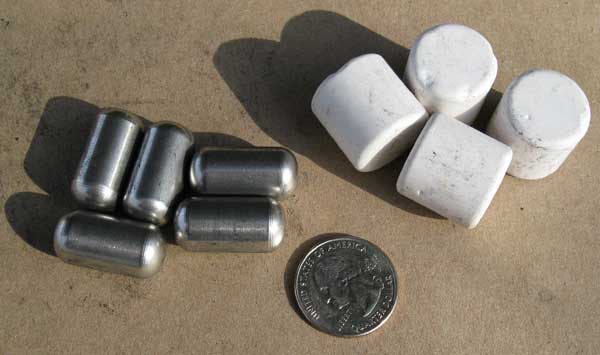Ball Milling Media Cautions
Milling Media Cautions
In his book Ball Milling Theory and Practice for the Amateur Pyrotechnician, Lloyd includes a section on casting your own lead media. Some folks melt used lead automobile wheel weights or hardened linotype as the raw material for casting media. Lloyd does begin this chapter with the warning, though: "Casting metals is dangerous. If you don't have experience, make up the molds, then seek a plumber or firearms reloader for assistance."
There are other types of media as well. Here's a shot of some stainless steel media and ceramic media. The stainless steel must be spark-resistant, non-magnetic steel in the 300-series. Alloys 304 and 316 are the most common stainless steels of this type. High-density alumina ceramic media is the type I've heard of most often being used in ball mills.

But, I must emphasize there is an ongoing discussion and debate about what is the "safest" media to use when milling. If one is milling only individual chemicals like charcoal or potassium nitrate, then any of these media are safe for crushing it. It is when one gets into milling mixed compositions like black powder that the dangers arise. We simply don't want sparks generated in the mill jar during that process for obvious reasons.
Each type of media has its advantages and disadvantages. I've used my stainless steel media for hundreds of mill runs with no problems. But I don't assume I won't have a mill explosion in the future. (More about safety precautions that take that into consideration in a moment.) Non-magnetic stainless steel is referred to as spark-resistant, not spark-proof. But it does give me very efficient milling in short times, and it never wears out.
Ceramic is hard, does not wear out quickly, but some types of ceramic do spark. Once again, many pyros have used it for all their mill runs, but that does not mean that the next time couldn't present a problem. Some people have said that if they bang pieces of their ceramic media together in the dark, they can see little sparks being generated. Others say that these are just little luminous 'light' sparks and they don't present a danger in milling.
Lead or brass is reliably the only really spark-free media and is considered to be the standard for milling comps like BP. But lead is softer than the other media and will wear down over time. If one mills a white powder like potassium nitrate with lead media, the powder will come out of the mill gray. That means there is some lead in the chemical, which will be in the smoke that results from it being burned. That presents a danger of lead poisoning if one breathes a lot of that smoke. But lead media has probably been and will continue to be used more than any other in amateur pyrotechnic milling.
Nothing is perfect. Everything presents some risk as well as benefit. We just have to weigh the plusses against the minuses and 'lay our money down.' Nothing in fireworks making is completely safe. But we can make wise decisions and then take steps to minimize the inherent risks. You're going to see in a minute that those of us who mill complete compositions assume that 'this time' the mill could explode. Even though it has never done so during the last 200 runs, we plan as if it will explode, and take the necessary precautions.
Lloyd's book has a great section on media selection, and a more thorough discussion of all the options. Let's face it. Banging our black powder between hard surfaces over and over is probably one of the least safe procedures we undertake in fireworking, but there are ways to prevent damage to persons or property during that operation in case there is an accident.
So, I am choosing the half-inch lead balls to mill with in this example. Lloyd, once again, says that "Balls between 1/2" and 1" in diameter are best for most of the sorts of grinding we do."
